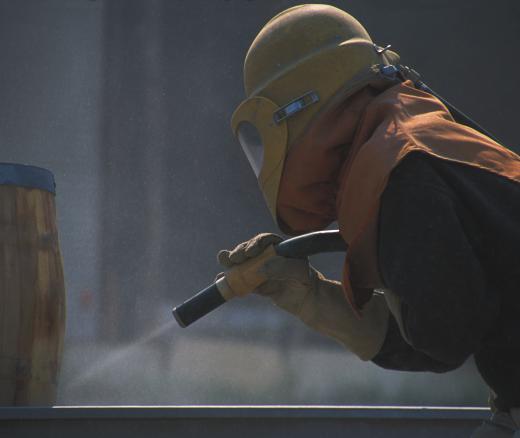There are several tips for sandblasting wooden signs, and most of them deal with methods of creating stencils. One tip is to use heavy tape, such as Duct® tape, to cover the wood where the effects of the sandblasting are not desired to show. Other tips for sandblasting signs deal with the type of blasting media to use for a given effect. Some tips for sandblasting signs revolve around the use of a blast cabinet and the size grit to use to create a particular outcome. Other tips for sandblasting signs focus on the type of wood to use for the best results.
Much like etched glass, wooden signs can be made by removing some of the surface material with a sandblaster. A sandblaster is a machine that combines compressed air with a blasting media, such as sand, walnut shells or baking soda. Using a fine stream of pressurized sand, the wood can be altered to show words, designs and a host of other images to create a very durable sign that will often last for years. The trick to sandblasting signs is to understand the best method of blasting the wood to reveal the sign's message or image. There are two types of masking to create a sandblasting sign: negative and positive masking.

When masking the wood to create a negative type of sandblasting sign, the tip is to mask off the area that makes up the sign and blast all of the wood around the masked area. When the masking is removed, the sign will appear to spring out of the wood. When creating a positive masking job, the area outside of the intended sign is masked and then the actual sign is sandblasted away, leaving the sign as a recessed image in the wood's surface. One tip that can lead to very precise sandblasting lines is to apply a vinyl decal to the wood as a masking material. The die cut vinyl can be made by most sign shops in a matter of minutes and used for sandblasting signs by placing the vinyl on the clean and dry wood surface.
A tip to create deep etching on the wood is to use a heavy grit sand, such as 30 grit. This will tend to dig deeper into the surface of the wood than a lighter grit, such as 80. As in sandpaper, the higher the grit number of the sand, the smoother the sand is, while a small number represents a very coarse grit. Higher number grit sand can be used for shading and creating lighter imaging in the wood's surface when sandblasting signs.
